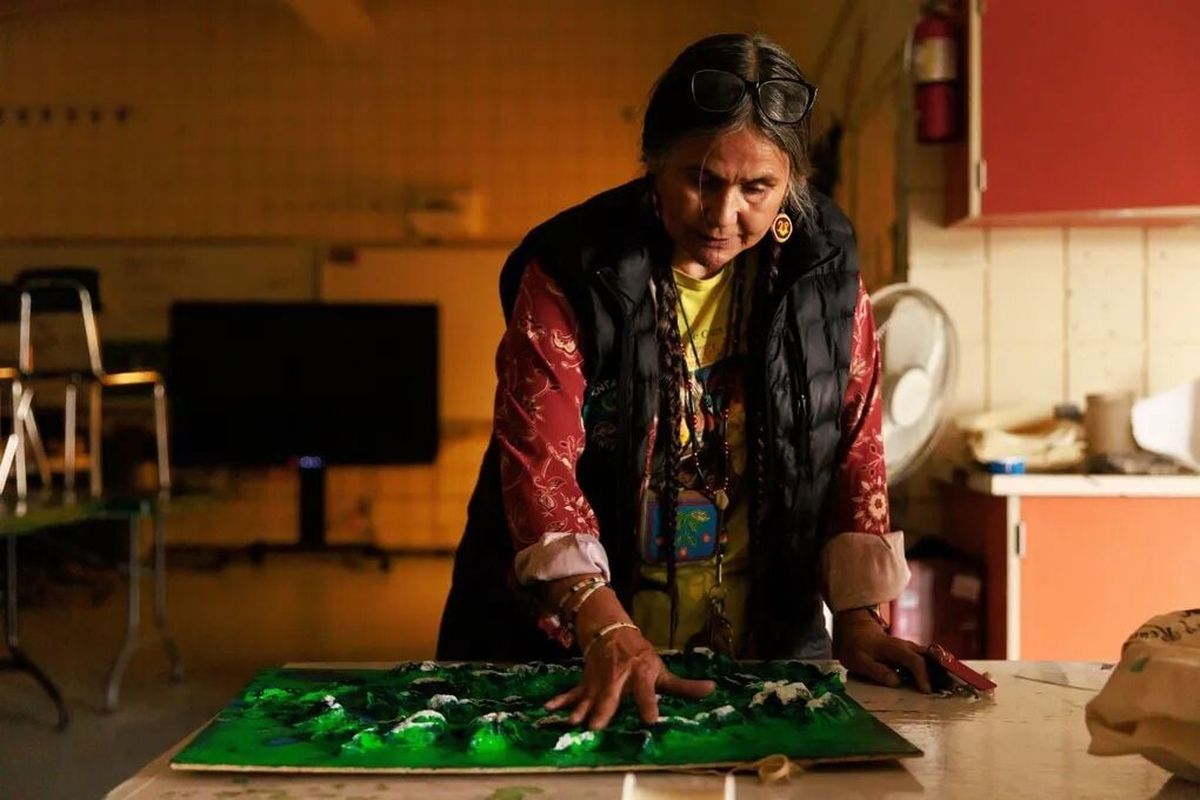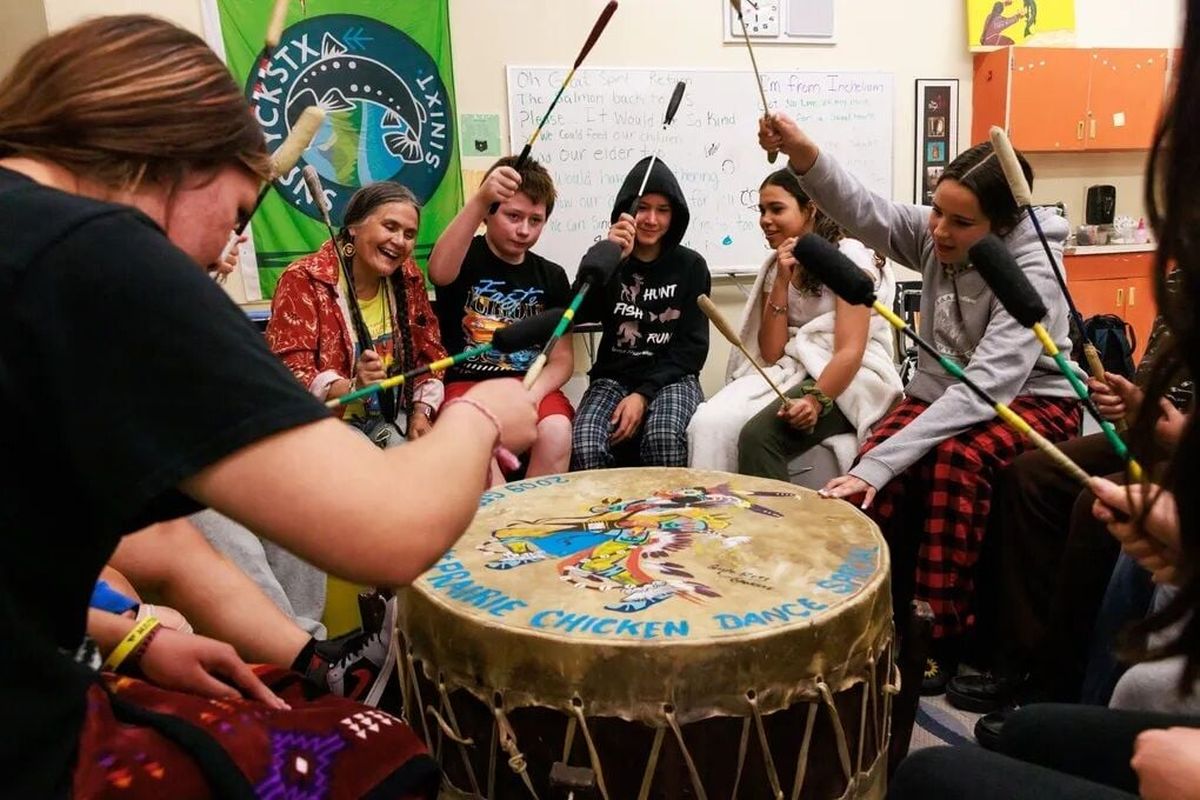How Sinixt people overturned their ‘extinct’ status and helped begin restoring Upper Columbia
Shelly Boyd shows a 3D map of Sn̓ʕay̓čkstx traditional territory created by her students at Inchelium School. (Erika Schultz/Seattle Times)
INCHELIUM, Colville Indian Reservation – Shelly Boyd traced her finger over a raised-relief map made by her students of the Sn̓ʕay̓čkstx traditional territory. She spoke of the great expanse, touching the now-drowned Kettle Falls on the Columbia River, the Selkirk Mountains and the big bend of the Kootenai River that snakes from British Columbia to the United States and back again.
In the span of a century, her people’s lands were stolen until nearly nothing was left.
Also known as the Sinixt, they were displaced first in Canada by greed, Boyd said, by the minerals found all through the Arrow Lakes. Many Sinixt people settled on the Colville Reservation (later cut in half by the U.S. after gold was found there). Canada declared the Sinixt extinct in 1956.
But the Sinixt people persevered, and in 2021 won a case all the way to the Canadian Supreme Court that restored their recognition as a people whose territory spanned international boundaries. The Sinixt have brought about changes in these communities, even as a new rush is underway for minerals to power a clean-energy transition.
The Sinixt people have helped hold a Canadian company, Teck Metals, responsible for pollution of the Columbia and are among those restoring salmon in their historical habitat.
Last year, the U.S. placed the Upper Columbia on its list of Superfund sites. Teck is funding Environmental Protection Agency’s lead testing of residential yards this spring. These are just some of the ways the Sinixt people have begun to regain some of what was lost, even though cleanup of the area is still years away from completion.
The cleanup work here also represents the complicated tangle of jurisdictions that need to cooperate to bring about real change for communities affected by a legacy of mining pollution.
“The hard truth is that we have been impacted by mining activities north of our border for decades,” said Casey Sixkiller, director of the Washington State Department of Ecology. The agency hopes to review plans in Canada to expand a mine at Copper Mountain.
In Boyd’s Inchelium School classroom last spring, her students illuminated a culture very much alive.
Taylor Signor pulled up a YouTube video of a drum group and students, turning her phone speaker so her classmates could hear the rhythm and song.
Students passed around a bundle of burning sage, guiding the sweet smoke over themselves and their drumsticks. Slowly, they began to drum as one, with Signor’s vocals guiding the group in the Warrior song.
“When we’re singing at the drum, for a lot of us, it connects us with our land and our cultures, and our ancestors, too,” Signor said. “It’s good medicine, it’s real good medicine.”
‘Winning it’
The late Jim Boyd, Shelly’s husband, a Sinixt member and a former Colville chairman, was part of the movement that led to the court case recognizing his people’s rights.
It began in 2010 when the Sinixt sent ceremonial hunter Rick Desautel into B.C. to hunt an elk. They wanted him to be charged for the unlicensed hunt to spark a test before the courts.
A provincial court judge acquitted Desautel, confirming the Sinixt were an Aboriginal Peoples of Canada.
The Sinixt did not “voluntarily and enthusiastically” choose allotments and farming over their traditional life, the provincial judge wrote; Instead, “it was a matter of making the best choice out of a number of bad choices.” Nothing in the evidence supports a finding that in doing so the Sinixt gave up their claim to their traditional territory, the judge wrote.
The Supreme Court of Canada overturned the 1956 declaration of extinction in a 7-2 ruling. The court wrote that “ an interpretation that excludes Aboriginal peoples who were forced to move out of Canada would risk perpetuating the historical injustice suffered by Aboriginal peoples at the hands of Europeans.”
“Why would we even think that we could win a case when we had won nothing historically?” Shelly Boyd said. “And not just to win that but to keep winning it and winning it.”
Superfund
DR Michel describes a childhood enriched by riding horses and bikes down to the water’s edge, catching fish from the river.
Michel, who is Sinixt, was then unaware of the legacy pollution looming in the water and sandy beaches.
By request of the tribes, the EPA’s regional office studied the river bottom. And in 2003, it found enough heavy metals to consider designating the area a high-priority cleanup site. The study would identify the Teck smelter across the border in Trail, B.C., as the “primary source” of contamination.
Michel was one of two Colville citizens to sue the company, then known as Teck Cominco, to compel cleanup responsibility.
Teck admitted it had intentionally discharged about 10 million tons of slag, along with industrial effluent containing hundreds of thousands of tons of toxic metals into the river.
Neither the company nor Canada were keen on cleaning up pollution in the U.S. under an American cleanup law.
In lieu of a formal agreement, the EPA announced last year it would proceed with the cleanup. It was just months after the cultural and educational releases of salmon above Grand Coulee Dam and their migration over the Canadian border.
The salmon have shown they remember, Michel said.
The fish had been blocked from their historical spawning habitat across the Upper Columbia’s vast reaches for more than 80 years. Now, the Colville, Spokane and Coeur d’Alene tribes are laying the groundwork for permanent fish passage and recovery in the Upper Columbia.
Calling the salmon home
Darnell Sam, salmon chief for the šnp̍əšqʷáw̉šəxʷ, one of the 12 Colville tribes, walked to the water’s edge at daybreak in early May. Here, on Icicle Creek near Leavenworth, Chelan County, exists one of the few salmon runs that can be harvested within the Colville tribes’ traditional territories.
A hatchery operation maintains the spring Chinook that return, feeding families as they have for generations. The hatchery was one of those built as mitigation for the decimation of salmon runs caused by Grand Coulee Dam.
Salmon are the first to come forward to feed the people, Sam said, and therefore the first food to be honored. Along with the symphony of crickets and red-winged blackbirds, Sam shared a blessing and returned the remains of the first salmon caught on this tributary to the water. Part of the ceremony is to give back to the water what it gives to us, Sam said, to make sure the nutrients stay within the system.
Twa-le Abrahamson, an enrolled member of the Spokane Tribe and a descendant of the Colville, Coeur d’Alene and Diné nations, arrived at the creek with an abundance of camas bulbs, bitter root and huckleberry in hand.
“For us, especially the foods, when they are outside of our reservation boundaries, we have less power to protect them,” Abrahamson said. “And what we experienced is increased pesticides, as well as lands and waters that have been contaminated by historic mining and smelting. We want to make sure we continue to pass these on, but need to make sure that they’re safe.”
Reporting for this project was supported in part by the Fund for Environmental Journalism of the Society of Environmental Journalists.

